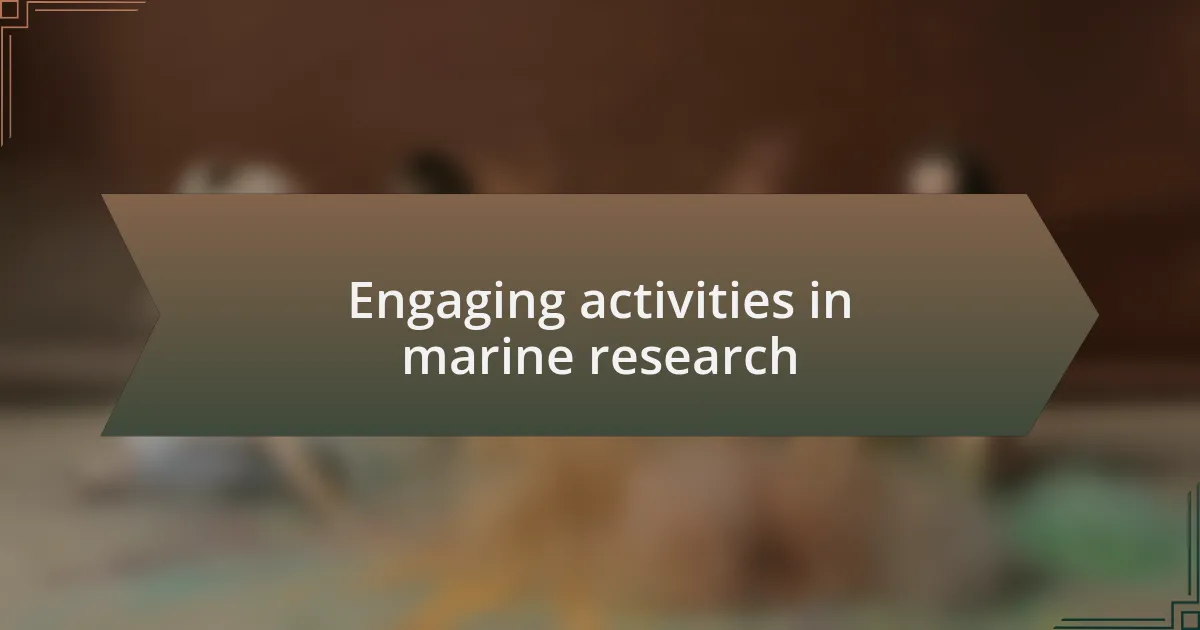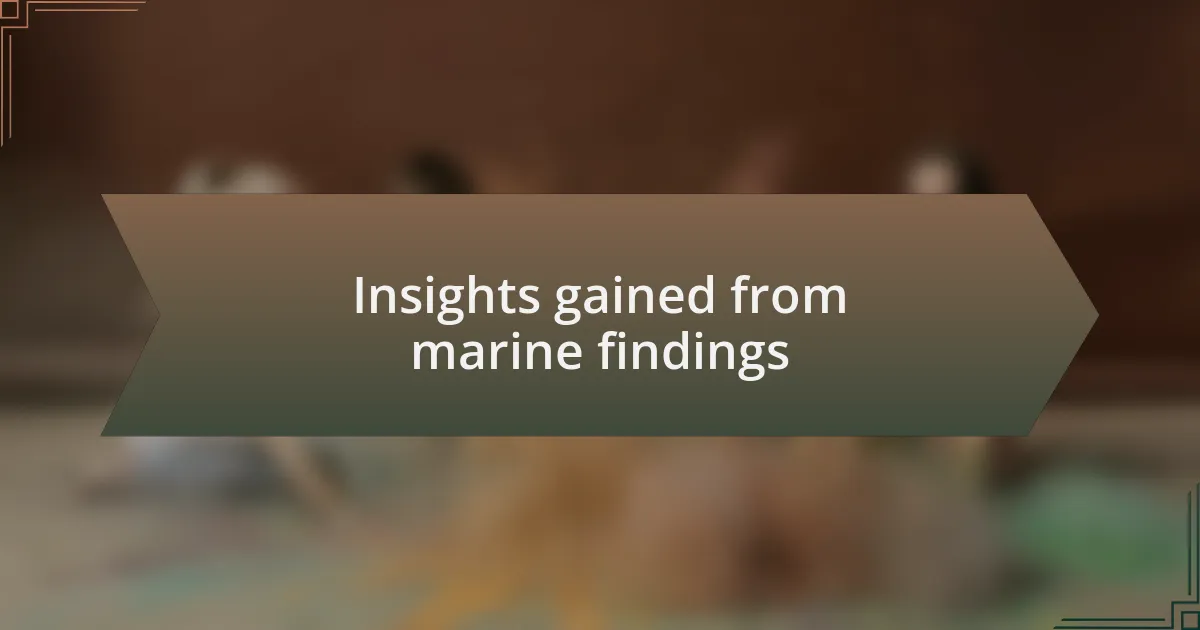Key takeaways:
- Marine research fosters a passion for conservation in children, enhancing their connection to the ocean and instilling a sense of responsibility for the environment.
- Engaging, hands-on activities, such as tide pooling and building models, spark curiosity and deepen understanding of marine ecosystems.
- Direct experiences with marine life, like observing plankton or coral reefs, enhance children’s appreciation for biodiversity and motivate them to advocate for environmental change.

Understanding marine research benefits
Marine research offers invaluable insights that extend far beyond the ocean’s surface. For instance, I’ve often found that learning about the delicate balance of marine ecosystems has ignited a passion for conservation in children. This connection to the ocean can transform their understanding and appreciation for nature, fostering a sense of responsibility toward protecting our planet.
When I first dove into the world of marine biology, I was captivated by the diversity of life beneath the waves—every creature, from the smallest plankton to the mighty blue whale, plays a role in our ecosystem. Have you ever taken a moment to wonder how these interconnected systems affect our own lives? Understanding this intricate web helps us realize that our actions matter, whether it’s reducing plastic use or supporting marine protected areas.
Additionally, engaging children with marine research can spark curiosity that lasts a lifetime. I recall a day spent tide pooling with kids, their eyes wide with excitement as they discovered starfish and crabs. These moments not only teach valuable scientific concepts but also create lasting memories and an emotional bond with the ocean. Isn’t it remarkable how such experiences can inspire the next generation to become stewards of the sea?

How marine research inspires curiosity
Marine research has a unique ability to awaken our sense of wonder, especially in children. I vividly remember a classroom visit where we observed a live octopus. The fascination sparked questions like, “How does it change color?” or “What does it eat?” It’s incredible how a single glimpse into the life of a creature can lead to a flurry of inquiries and excitement about the underwater world.
I’ve noticed that when children engage with marine environments—whether through hands-on activities like building a marine habitat model or taking field trips to aquariums—they often express an insatiable curiosity. During a beach cleanup, I facilitated a discussion on the impact of pollution. The questions that arose were so profound; kids wanted to know what they could do to help. This desire to learn more and contribute positively to ocean health reflects how marine research can fuel their eagerness to explore and understand the complexities of our natural world.
Participating in marine research can also transform passive learning into active exploration. I once led a workshop on plankton collection, and the enthusiasm was palpable as we examined these tiny organisms under microscopes. Witnessing the joy on a child’s face as they identified a species was truly inspiring. It reminded me how these experiences enable young minds to connect abstract concepts to real-life habitats, fostering a profound curiosity that encourages them to seek answers beyond the classroom.

Engaging activities in marine research
Engaging activities in marine research can open up a treasure trove of discovery for children. For instance, I once organized a trip where kids got to participate in a “mini marine expedition,” helping to collect water samples from a local harbor. They were thrilled to don their lab coats and wield science tools, asking enthusiastic questions like, “What will we find?” That hands-on involvement brings the scientific process to life, making each discovery feel like a big adventure.
Another memorable experience involved constructing coral reef models from recycled materials. As the kids worked together, glue and paint flying everywhere, they sparked conversations about marine ecosystems and the importance of coral conservation. Their curiosity was contagious, perfectly captured in one child’s comment, “Can we build a real reef?” It’s amazing how such activities can ignite a deeper understanding of marine environments while fostering teamwork and creativity.
One time, I introduced a simple experiment to observe how oil spills affect water quality using a clear container and different liquids. Watching their surprise as they saw oil float and form a barrier demonstrated a vital lesson in environmental science. It made me think, how often do we get to witness science in action? These engaging activities are not just fun; they provide vital, firsthand experiences that help children grasp complex scientific concepts in an unforgettable way.

Personal experiences with marine research
I vividly remember the day I guided a group of young explorers during a tide pool investigation. As we peered into the shallow water, their eyes widened with wonder at the vibrant sea stars and curious crab scuttling away. I couldn’t help but smile at one child who gasped, “Look at all these animals! Are they really alive?” That moment encapsulated the magic of marine research—witnessing genuine awe can deepen a child’s thirst for knowledge and connection to our oceans.
On another occasion, I led an interactive session where we examined plankton samples under a microscope. The kids’ faces lit up with excitement as they saw these tiny organisms come to life on the screen. One child exclaimed, “It’s like a whole world we can’t even see!” This experience reminded me of how often we overlook the unseen wonders around us. Engaging with marine research doesn’t just teach science; it nurtures an appreciation for the intricate ecosystems that sustain us.
Looking back, I realize how my experiences with marine research have shaped my understanding of conservation. Leading a beach cleanup effort was not just about picking up trash; it was about instilling a sense of responsibility in the children. They learned that every piece of litter they collected was a step toward protecting marine life. The pride on their faces when they filled their buckets was a powerful reminder of how personal involvement can inspire lasting change.

Insights gained from marine findings
Engaging with marine findings provides a unique window into the delicate balance of our ecosystems. During a recent field trip, while studying coral reefs, I was struck by how intertwined the lives of various species are. It made me wonder: how do small changes, like temperature shifts, impact these vibrant communities? Observing the subtle connections helped me realize that even the slightest action can ripple through the entire marine environment, highlighting the importance of every single organism.
On another occasion, while diving to collect data on fish populations, I experienced an overwhelming sense of awe. I remember vividly seeing a school of colorful fish darting among the corals, and I couldn’t help but feel a profound respect for their habitat. Each dive left me contemplating not just the beauty of what I saw, but also the responsibility we share in protecting these underwater realms. It’s fascinating how direct experience evokes a deeper understanding of biodiversity and our role as stewards.
One particularly memorable interaction happened when I shared findings about ocean acidification with a group of students. Their faces turned serious as we discussed how our actions affect marine life, especially mollusks and corals. I posed the question, “What happens when our choices change the ocean’s chemistry?” Their thoughtful replies revealed a surprising depth of understanding. It emphasized to me that when children engage in discussions about such topics, they don’t just learn—they become advocates for change, motivated to make a difference in the world.
Encouraging exploration in children’s education
Encouraging exploration in children’s education is essential in helping them develop critical thinking skills. I remember a local school project where students transformed their classroom into a mini-laboratory, conducting experiments on water quality from local streams. Watching their excitement as they tested pH levels and observed changes was enlightening; it reminded me how hands-on experiences spark curiosity and a desire to learn more about the world around them.
In my experience, children often grasp complex concepts when they relate them to tangible experiences. For instance, during a beach cleanup with a group of eager learners, we discovered objects like plastic bottles and fishing nets washed ashore. I asked them, “How do you think these items affect marine life?” Their engagement deepened as they realized the impact of pollution firsthand, fostering a sense of responsibility that textbooks alone could never evoke.
Moreover, creating an environment where children can ask questions freely benefits their educational journey immensely. I recall encouraging a shy student to share her thoughts on ocean currents, which had once seemed too complex to discuss. Her insights sparked a passionate discussion among her classmates, transforming her uncertainty into confidence. This moment reinforced my belief that by fostering exploration and dialogue, we nurture not just knowledge, but also empathy and environmental stewardship.